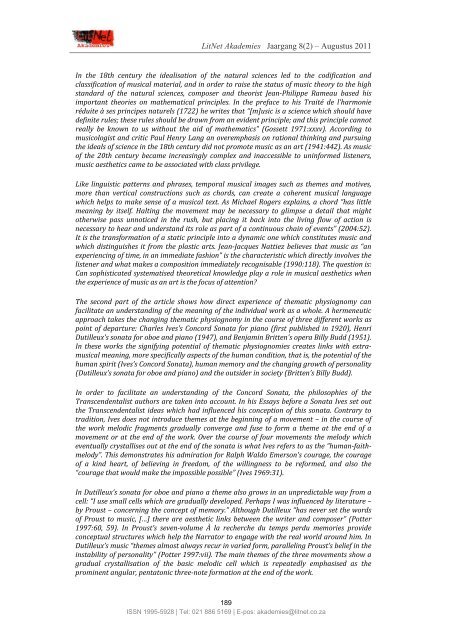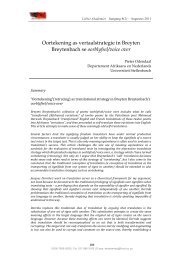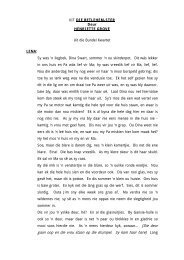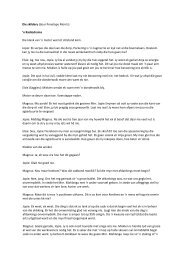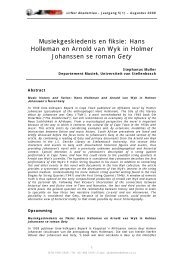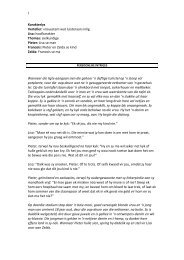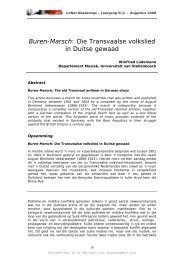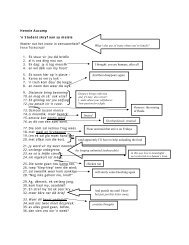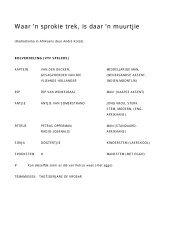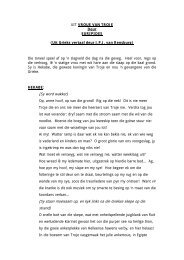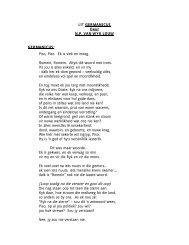Jaargang 8, nommer 2 – Augustus 2011 - LitNet
Jaargang 8, nommer 2 – Augustus 2011 - LitNet
Jaargang 8, nommer 2 – Augustus 2011 - LitNet
You also want an ePaper? Increase the reach of your titles
YUMPU automatically turns print PDFs into web optimized ePapers that Google loves.
<strong>LitNet</strong> Akademies <strong>Jaargang</strong> 8(2) <strong>–</strong> <strong>Augustus</strong> <strong>2011</strong><br />
In the 18th century the idealisation of the natural sciences led to the codification and<br />
classification of musical material, and in order to raise the status of music theory to the high<br />
standard of the natural sciences, composer and theorist Jean‐Philippe Rameau based his<br />
important theories on mathematical principles. In the preface to his Traité de l’harmonie<br />
réduite à ses principes naturels (1722) he writes that “[m]usic is a science which should have<br />
definite rules; these rules should be drawn from an evident principle; and this principle cannot<br />
really be known to us without the aid of mathematics” (Gossett 1971:xxxv). According to<br />
musicologist and critic Paul Henry Lang an overemphasis on rational thinking and pursuing<br />
the ideals of science in the 18th century did not promote music as an art (1941:442). As music<br />
of the 20th century became increasingly complex and inaccessible to uninformed listeners,<br />
music aesthetics came to be associated with class privilege.<br />
Like linguistic patterns and phrases, temporal musical images such as themes and motives,<br />
more than vertical constructions such as chords, can create a coherent musical language<br />
which helps to make sense of a musical text. As Michael Rogers explains, a chord “has little<br />
meaning by itself. Halting the movement may be necessary to glimpse a detail that might<br />
otherwise pass unnoticed in the rush, but placing it back into the living flow of action is<br />
necessary to hear and understand its role as part of a continuous chain of events” (2004:52).<br />
It is the transformation of a static principle into a dynamic one which constitutes music and<br />
which distinguishes it from the plastic arts. Jean‐Jacques Nattiez believes that music as “an<br />
experiencing of time, in an immediate fashion” is the characteristic which directly involves the<br />
listener and what makes a composition immediately recognisable (1990:118). The question is:<br />
Can sophisticated systematised theoretical knowledge play a role in musical aesthetics when<br />
the experience of music as an art is the focus of attention?<br />
The second part of the article shows how direct experience of thematic physiognomy can<br />
facilitate an understanding of the meaning of the individual work as a whole. A hermeneutic<br />
approach takes the changing thematic physiognomy in the course of three different works as<br />
point of departure: Charles Ives's Concord Sonata for piano (first published in 1920), Henri<br />
Dutilleux's sonata for oboe and piano (1947), and Benjamin Britten's opera Billy Budd (1951).<br />
In these works the signifying potential of thematic physiognomies creates links with extra‐<br />
musical meaning, more specifically aspects of the human condition, that is, the potential of the<br />
human spirit (Ives’s Concord Sonata), human memory and the changing growth of personality<br />
(Dutilleux’s sonata for oboe and piano) and the outsider in society (Britten’s Billy Budd).<br />
In order to facilitate an understanding of the Concord Sonata, the philosophies of the<br />
Transcendentalist authors are taken into account. In his Essays before a Sonata Ives set out<br />
the Transcendentalist ideas which had influenced his conception of this sonata. Contrary to<br />
tradition, Ives does not introduce themes at the beginning of a movement <strong>–</strong> in the course of<br />
the work melodic fragments gradually converge and fuse to form a theme at the end of a<br />
movement or at the end of the work. Over the course of four movements the melody which<br />
eventually crystallises out at the end of the sonata is what Ives refers to as the “human‐faith‐<br />
melody”. This demonstrates his admiration for Ralph Waldo Emerson's courage, the courage<br />
of a kind heart, of believing in freedom, of the willingness to be reformed, and also the<br />
“courage that would make the impossible possible” (Ives 1969:31).<br />
In Dutilleux’s sonata for oboe and piano a theme also grows in an unpredictable way from a<br />
cell: “I use small cells which are gradually developed. Perhaps I was influenced by literature <strong>–</strong><br />
by Proust <strong>–</strong> concerning the concept of memory.” Although Dutilleux “has never set the words<br />
of Proust to music, […] there are aesthetic links between the writer and composer” (Potter<br />
1997:60, 59). In Proust’s seven‐volume À la recherche du temps perdu memories provide<br />
conceptual structures which help the Narrator to engage with the real world around him. In<br />
Dutilleux’s music “themes almost always recur in varied form, paralleling Proust’s belief in the<br />
instability of personality” (Potter 1997:vii). The main themes of the three movements show a<br />
gradual crystallisation of the basic melodic cell which is repeatedly emphasised as the<br />
prominent angular, pentatonic three‐note formation at the end of the work.<br />
189<br />
ISSN 1995-5928 | Tel: 021 886 5169 | E-pos: akademies@litnet.co.za


